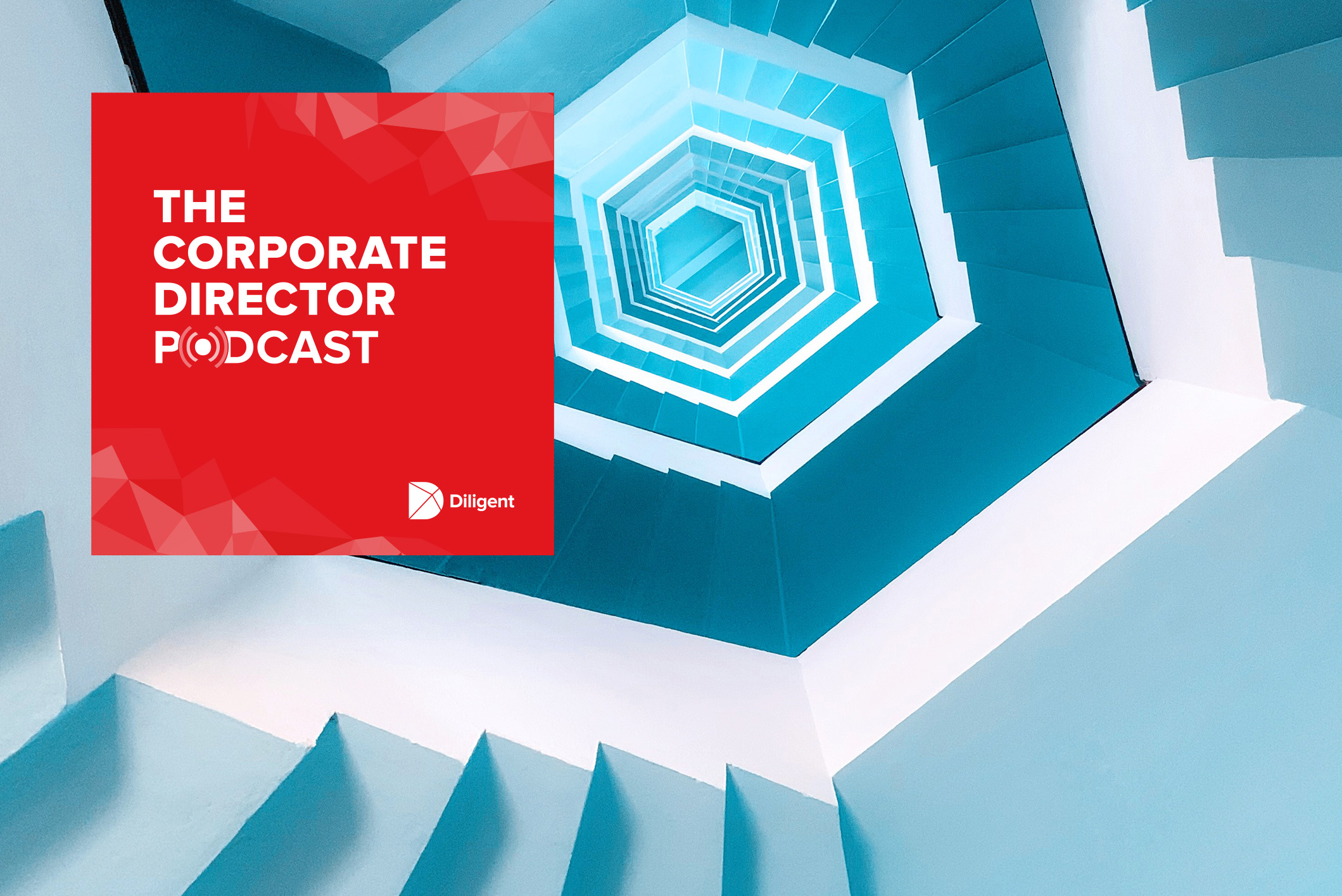Listen to Episode 33 on Apple Podcasts
Guest: Eileen Kamerick, board member, AIG Funds, Associated Banc-Corp, Legg Mason Closed-End Mutual Funds, and Hochschild Mining
Hosts: Dottie Schindlinger, Executive Director of the Diligent Institute, and Meghan Day, Senior Director of Board Member Experience for Diligent Corporation
In this episode:
- Videoconferencing is spurring directors to streamline agendas. Blame “Zoom fatigue,” says Kamerick.
- Materials may get whittled down as well. Could four-slide board presentations actually happen?
- Boards should prioritize quality over quantity in discussions and debate. To determine the critical issues, focus in on performance management, strategy, and succession, Kamerick advises.
Summary
The pandemic is transforming how corporate boards conduct business. For starters, with months of virtual meeting experience now behind them, most board members have largely mastered this tricky terrain.
“It’s amazing how quickly people have adopted tools like Zoom, WebEx, and Microsoft Teams, and incredible that audits can get done remotely. People who have not used this technology before are being forced to, and they have really embraced it,” says Eileen Kamerick.
Can boards apply the best habits of today’s virtual meetings to more effective operations beyond the COVID-19 crisis?
Kamerick brings a particularly rich perspective on the subject. She serves on the boards of four companies—AIG Funds, Associated Banc-Corp, Legg Mason Closed-End Mutual Funds, and Hochschild Mining—and chairs three audit committees and one corporate governance committee. From all of the virtual meetings she’s attended since March, and her extensive governance and corporate leadership experience, she has some insights and suggestions.
Here Kamerick joins co-hosts Dottie Schindlinger and Meghan Day to talk about what she’s seeing and how lessons learned could—and should—shape the future.
Videoconferencing is spurring boards to streamline agendas.
“As a result of the need to go virtual, and to focus on critical matters during these very tumultuous times, I see many boards really streamlining their agendas.”
– Eileen Kamerick, board member, AIG Funds, Associated Banc-Corp, Legg Mason Closed-End Mutual Funds, and Hochschild Mining
Though tools like WebEx have allowed boards to keep meeting during the pandemic, Kamerick notes growing evidence that videoconferencing can also be stressful. Particularly during long director and board meetings, participants can experience “Zoom fatigue.” Furthermore, she observes, “Virtual meetings really don’t replace human interactions between management and directors.”
To accommodate, boards have been streamlining their agendas to the essentials, like risk assessment and COVID-19 response. Kamerick recommends such prioritization continue into the future. For example, any purely informational parts of meetings, like recurring reports, could be conveyed in written form, similar to a company’s quarterly financial statements. This reserves discussion for the most complex and high-priority topics.
Agenda packets may get whittled down as well.
“The world has been overrun by clever presentations with moving arrows and busy pages full of data and a dearth of real analysis,” says Kamerick. Virtual meetings make the information overload worse.
“Just because it’s easy to upload 3,000 pages into Diligent doesn’t mean it’s a good idea.”
– Eileen Kamerick, board member, AIG Funds, Associated Banc-Corp, Legg Mason Closed-End Mutual Funds, and Hochschild Mining
How can boards cope? Kamerick shares one colleague’s antidote: a mandated four-slide template comprised of:
- One page for the budget
- One page for year-over-year results
- A page for opportunities and challenges, and…
- One page of narrative.
While this example may be extreme and unrealistic for many boards, Kamerick advocates for “boards being more proactive in dialoguing with management regarding what they want to see and in what format.”
“I really think that the touchstone of board materials should be fostering robust discussion and debate on the critical issues facing the organization,” she says. “Boards are well advised to work in partnership with management to design materials that frankly raise the hard questions.”
Boards should prioritize quality over quantity in their agendas.
When it comes to both board materials and the conversations they inspire, prioritize quality over quantity, Kamerick advises. “Fewer in-depth discussions of critical topics are much more productive than a long march through many half-hour overviews.” says Kamerick.
“Board materials should be fostering robust board discussions and debates on the critical issues facing an organization.”
– Eileen Kamerick, board member, AIG Funds, Associated Banc-Corp, Legg Mason Closed-End Mutual Funds, and Hochschild Mining
How can boards determine the topics most worthy of attention, particularly when an urgent crisis isn’t dominating the landscape? Consider the three touchstones of performance management, strategy, and succession, according to Kamerick.
With these in mind, she says, boards can be be thoughtful about what they’re trying to share, the materials that the director see, and how to engender robust conversations.
Also in this episode . . .
Kamerick shares a reading recommendation and a “passion project,” both with a Jesuit connection. (“Once the Jesuits pull you in, you’re with them for life,” she quips.)
The reading recommendation is Chris Lowney’s book Heroic Leadership: Best Practices for a 450-Year-Old Company That Changed the World. The book examines leadership through four pillars; great leaders are self-aware, heroic, ingenious, and loving.
The passion project is the Cristo Rey Network, a network of high schools serving students from families of limited economic means. The schools integrate college preparatory academics and professional work experience into a corporate work study program and have graduated 18,000 graduates across 24 states.
“It’s something that I’ve been involved with in a long time, and I think it’s especially important given all that’s going on right now,” she says. “I’ve seen what a dramatic difference it’s made in the opportunities that students have had and in the trajectory of their lives.”
Resources in this episode
- Heroic Leadership: Best Practices for a 450-Year-Old Company That Changed the World
- Cristo Rey Network


